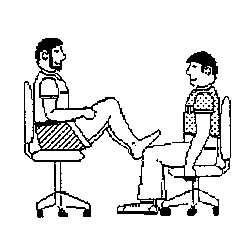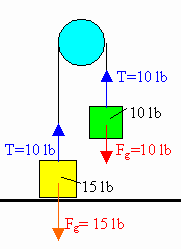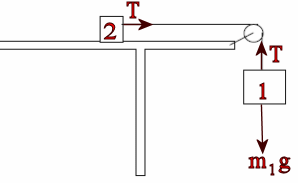 Consider the following situations:
Consider the following situations: Consider the following situations:
Consider the following situations:
What is happening is a consequence of Newton's third law.
For every force that an
object exerts on a second object, there is a force equal in magnitude but
opposite in direction exerted by the second object on the first object.
Forces are the result of interactions.
You pull on me, I pull on you. If no other forces are present, I will accelerate towards you. My acceleration has
the magnitude of the force divided by my mass. You will accelerate
towards me. Your acceleration has the magnitude of the force divided by your mass.
You push against the table, the table pushes against you. You accelerate away from the table. Why is the table not accelerating away from you?
Standing on a very slippery surface or on a skateboard, you throw a heavy object away from you in a northerly direction. To do this, you have to exert a force on the object in the northerly direction. The object exerts a force on you, which has equal magnitude but points towards the south. You accelerate southward.
Newton's third law is also called the law of action and reaction. For every action force, there exists a reaction force, equal in magnitude and opposite in direction. The objects interact.
The action and reaction force always act on different objects.
Two forces acting on the same object, even if they have the same
magnitude and point in opposite direction, never form an action-reaction pair.
An apple with a 0.2 kg mass sits on a table in equilibrium.
(a) What forces act on it? Provide their magnitude and direction.
(b) What is the reaction force to each of the forces acting on the apple?
(c) What are the action-reaction pairs?
Solution:
Action-reaction pairs are forces of equal magnitude and opposite direction that act on different object. They never act on the same object.
Newton's 3rd law tells us that forces are interactions. An object cannot exert a force on another object without feeling a reaction force itself. The reaction force has the same magnitude and points in the opposite direction as the force the object exerts on the other object. What an object does as a result of being acted on by a reaction force depends not only on the reaction force but on the net force acting on the object. The net force is the sum of the reaction force and all the other forces acting on the object.
Newton's 3rd law is simple, forces are interactions.
Newton's second law is complicated, Fnet = ma, because
you need to know all the forces, and you need to add them as vectors. Only then
can you figure out if the object accelerates, and if yes, how much and in which
direction.
External link: Physics of Football - Newton's Third Law of Motion - YouTube
AI Study Tip:
Example prompts:
'I am struggling with Newton's Third Law. If I kick a soccer ball, the
ball pushes back on my foot with the exact same amount of force that I apply to
it. If the forces are equal and opposite, why does the ball move at all?
Explain this using the concept of 'system boundaries' and 'internal vs. external
forces' at a college physics level.'
'Act as a physics professor. I will explain Newton's three laws of motion to you in my own words. After I explain each one, tell me if I have any 'ommon misconceptions (like confusing velocity with acceleration) and give me a sanity check question to see if I truly understand Newton's laws.'
A device used since the 1940s to measure the kick or recoil of the body due to heart beats is the "ballistocardiograph". What physics principle(s) are involved here to measure the force of cardiac contraction? How might we construct such a device?
Discuss this with your fellow students in the discussion forum!
Suppose that you are holding a cup of coffee in your hand. Identify all forces on the cup and the reaction to each force.
Discuss this with your fellow students in the discussion forum!
Assume two opposing teams are pulling on a rope in opposite directions. Is there a net force on the rope?
If the rope is accelerating in the direction of one of the teams, then there is a non-zero net force. F = ma. The net force is the vector sum of the force of gravity and the forces exerted by the two teams.
If the rope is not accelerating, even so each team is pulling as hard as it
can then there is no net force acting on the rope. However, there is tension in the
rope. Tension results from different forces acting on different parts of
the body. Tension can break things. A pure force, i.e. the same force
acting on all parts of the body, cannot break things.
If instead of
pulling on the rope the two teams push on a heavy rock, but the rock does
not move, then again the net force on the rock is zero. However, now the
rock is under compression.
The tension T is a scalar. It is defined as the magnitude of the force with which the stretched rope pulls on whatever it is attached to. This force is often denoted by T. The direction of T depends on which end of the rope is being considered.
The net force acting on an object is always the vector sum of all forces acting on an object. The object's acceleration is in the direction of this net force and has magnitude a = (net force/object's mass).
Tension happens with extended object. Two forces act on the object at
different points, pulling in opposite direction. The net force is zero of
the two forces have equal magnitudes.
Internal "contact forces keep the object from breaking apart, but the object is
under tension. It usually stretches a small amount, and if the tension
becomes too large, it breaks.
Compression also happens with extended object. Two forces act on the
object at different points, pushing in opposite direction, squeezing the object.
A 15-lb block rests on the floor. (Note: lb is a
unit of force, the weight of the block is 15 lb.)
(a) What
force does the floor exert on the block?
(b) If a rope is tied to
the block and run vertically over a pulley and the other end is attached to
a free-hanging 10-lb weight, what is the force exerted by the floor on the
15-lb block?
(c) If we replace the 10-lb weight in part (b) with a
20-lb weight, what is the force exerted by the floor on the 15-lb block?

Solution:
 Two
blocks, one sitting on a table and the other heavier one hanging over its edge,
are connected by a light string as shown in the figure. Which force
makes the block on the table accelerate, the tension in the string or the weight of
the hanging block? Write down an expression for the acceleration a.
Two
blocks, one sitting on a table and the other heavier one hanging over its edge,
are connected by a light string as shown in the figure. Which force
makes the block on the table accelerate, the tension in the string or the weight of
the hanging block? Write down an expression for the acceleration a.
Solution: